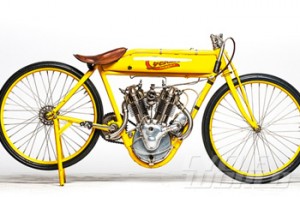After sitting for months motorcycles need attention before returning to service, which can also help avoid breakdowns and ensure safety. Refer to the owner’s and service manuals for inspection lists before giving your bike a thorough going over.
Look for any signs of leakage, such as stains underneath that indicate problems. Check steering head bearings for looseness or binding. To get the best performance out of a hydraulic fork change the fluid every year or two.
Clean the battery terminals. Check the electrolyte level (if caps are removable) and add distilled water as needed. (Warning: Electrolyte contains acid so avoid contact and wear eye protection. Baking soda and water will neutralize the acid.) If the battery wasn’t on a maintenance charger it’ll probably be weak or dead. Turn on the ignition briefly and note how bright the lights are. If the lights are dim or don’t work, charge the battery. If the battery was fully discharged it’s likely sulfated and needs replacement.
Unless you put in fuel-stabilizer additives before storage, after several months the gasoline may begin to form deposits in carburetor jets and passages, and may also clog injectors and electric fuel pumps. Remove the gas cap and peer into the tank with a small flashlight (switch it on first to avoid sparks), look for rust in steel tanks, and note if the fuel has sediment or other contamination. Give the gas a quick sniff. If it smells like old varnish the fuel system may need to be drained, flushed, and the fuel filter replaced. Carburetor float bowls (if equipped) must also be drained before new gas is added. If a motorcycle won’t start because the fuel system is gummed up it may require disassembly and a thorough cleaning.
Check the oil level and note the color of the oil, as old, dirty oil leaves sludge and deposits in the engine. If it is dark or the level is low change the oil and filter before starting the engine. If the oil isn’t too bad it’s better to start the engine and allow it to warm up to allow contaminants to be suspended in the oil, and then drain it. If your motorcycle has a separate transmission or primary-chain case oil supply, service that, too. Always recycle used oil and dispose of filters properly.
Inspect tires for cracks, wear, and damage. Tires more than about five or six years old should be replaced even if they aren’t worn out. After a thorough inspection inflate the tires to the recommended pressure in the owner’s manual.
Check your maintenance records and schedule to determine if the motorcycle is due for a major service, including a tune-up and valve adjustment. If not it’s still a good idea to check the spark plugs for condition and measure the gap. Put a little anti-seize compound on the threads and torque properly – do not over-tighten them. Inspect the plug wires and boots and clean or replace them if they look worn or cracked. Also check the air filter and replace as needed.
Liquid-cooled engines should have the antifreeze/coolant checked, flushed, and replaced every two years, as old coolant causes corrosion. Also replace the hoses, thermostat, and radiator cap every five years. After starting the engine test the operation of the electric cooling fan. It should come on during extended idling.
Inspect the brake linings and rotors or drums for wear. Check the brake fluid, which should be changed every two years, and if it looks dark replace it. Refer to the shop manual for the bleeding procedure, especially on ABS systems.
Control cables should be serviced every year. Check the throttle cables and clutch cable (if equipped) for free travel and lube with special cable lubricant.
Inspect the sprockets and chain (if equipped) and make sure they are properly lubed and adjusted. Belt drives and sprockets should be inspected and adjustment checked. Shaft-drive machines should have the gear lube level checked and changed if it has been several years since this was done.
Start the engine and allow it to warm up gently without revving. After the engine is up to normal operating temperature, check the idle speed and adjust if needed. Test all controls, lights, and accessories to ensure they’re working properly. Addressing these items before you ride can save a lot trouble down the road.
Michael Theodore
Azusa StreetRiders National Road Captain
Latest posts by Michael Theodore (see all)
- Happy New Year 2024 - December 31, 2023
- Letter from the Pres. - December 31, 2023
- “17 INCHES” - December 30, 2023

